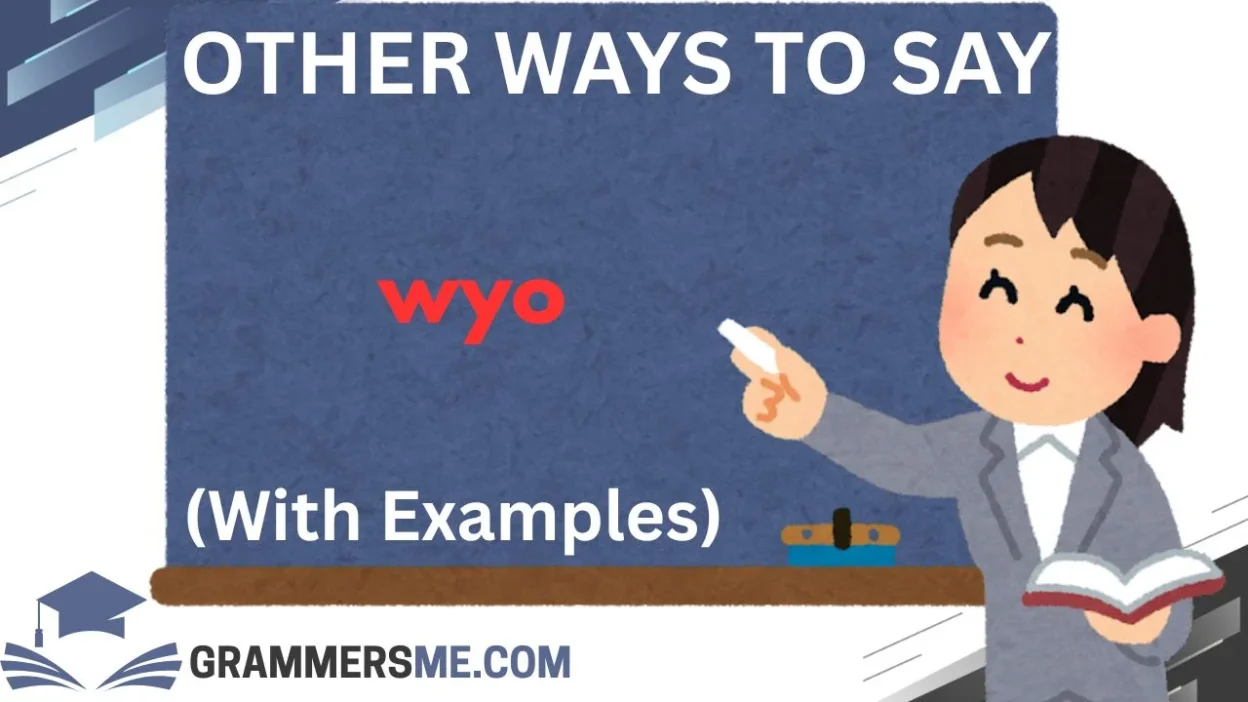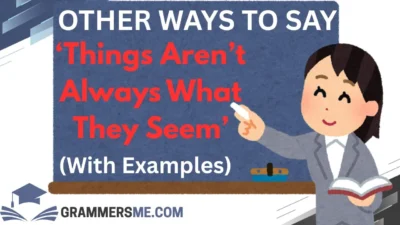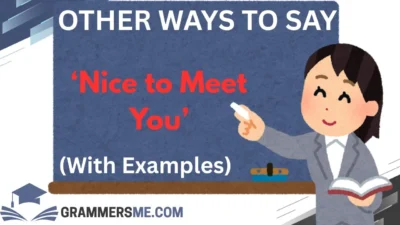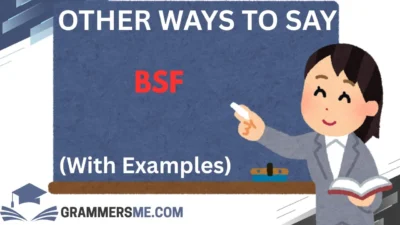We all crave connection. Sometimes, all it takes is a simple message like “wyo”—short for “what you on?”—to open the door for conversation. But what if you want your words to feel more intentional, caring, or just a little more personal? Whether you’re chatting with friends, checking in on someone you care about, or trying to start a warm, meaningful convo, the way you say “wyo” can set the tone.
Here are 30 thoughtful and expressive alternatives to “wyo”, each designed to help you communicate with heart, clarity, and presence.
What Does “wyo” Mean?
“WYO” is a casual abbreviation for “what you on?”, which loosely means “what are you up to?”, “what’s going on?”, or “what are your plans?” It’s often used in friendly or flirty texts to start a convo or check in.
It’s mostly used in texting, especially among Gen Z and Millennials, and sets a chill, laid-back tone.
Is It Professional/Polite to Say “wyo”?
Not really. While “wyo” is fine in casual chats with friends or close contacts, it doesn’t fit professional or formal conversations. In those settings, go for more polite or complete expressions like:
- “What are you working on today?”
- “Do you have any plans this afternoon?”
If you’re messaging someone you’re not close with or trying to show a little more respect or warmth, you’ll want alternatives that feel more intentional and caring.
1. What’s on your mind?
Meaning: Asking someone what they’re thinking about or dealing with at the moment.
Explanation: This version feels more personal and introspective than “wyo.”
Example: “Hey, just checking in—what’s on your mind today?”
Best Use: When you want to have a real, deeper conversation.
Not Use: If you’re just looking for casual small talk.
2. What are you up to?
Meaning: A friendly way to ask what someone is doing.
Explanation: It’s probably the closest, full-length version of “wyo.”
Example: “What are you up to this evening?”
Best Use: Everyday convo with friends, partners, or family.
Not Use: When you’re trying to be very formal.
3. Got any plans?
Meaning: Asking if the person has anything scheduled or going on.
Explanation: Light and friendly, it gives space for someone to open up.
Example: “Got any plans this weekend?”
Best Use: Inviting someone to hang out or start a weekend convo.
Not Use: When you’re seeking emotional depth.
4. What’s going on?
Meaning: Asking about what’s currently happening in their life.
Explanation: Simple, familiar, and welcoming.
Example: “Hey! What’s going on with you these days?”
Best Use: Regular check-ins.
Not Use: In highly emotional or sensitive moments.
5. How’s everything?
Meaning: A casual yet caring way to ask how someone is doing.
Explanation: It’s general, so it works in a variety of situations.
Example: “Hey there, how’s everything going on your end?”
Best Use: Checking in without sounding nosy.
Not Use: When you want specifics right away.
6. You good?
Meaning: A casual way of checking in to make sure someone’s okay.
Explanation: Short but meaningful when used in a genuine tone.
Example: “Yo, you good? Haven’t heard from you in a bit.”
Best Use: Quick emotional check-ins.
Not Use: With people who may misread the tone.
7. What’s happening?
Meaning: Another relaxed way to ask what someone is doing.
Explanation: Slightly retro and fun, depending on your delivery.
Example: “What’s happening with you lately?”
Best Use: Friends you haven’t spoken to in a while.
Not Use: In formal or new relationships.
8. What’s the vibe?
Meaning: Asking about their mood, setting, or what’s going on.
Explanation: It’s casual and current, especially among younger folks.
Example: “What’s the vibe tonight? You going out or chilling?”
Best Use: Planning hangouts or matching energy.
Not Use: Older audiences might not relate to the term.
9. What are you doing?
Meaning: Direct question about their current activity.
Explanation: It’s to-the-point but can come across blunt without tone.
Example: “Hey, what are you doing right now?”
Best Use: When you’re ready to meet or call.
Not Use: When tone is hard to read over text.
10. How’s your day going?
Meaning: A warm, everyday question.
Explanation: Shows you care, even if you’re just starting small talk.
Example: “Hey! How’s your day going so far?”
Best Use: Opening friendly or sweet conversations.
Not Use: If you’re looking for specific plans or actions.
11. What’s new?
Meaning: Asking what’s changed or happening in their life.
Explanation: Great for people you haven’t spoken to in a while.
Example: “Hey stranger! What’s new with you?”
Best Use: Reconnecting after a break.
Not Use: Daily check-ins—feels repetitive.
12. Wanna hang out?
Meaning: An invite to spend time together.
Explanation: Goes beyond asking what they’re doing—offers your time.
Example: “Wanna hang out later tonight?”
Best Use: Friends, crushes, or partners.
Not Use: With someone you don’t know well.
13. What’s up?
Meaning: A classic, casual greeting or question.
Explanation: Timeless and familiar, though not very specific.
Example: “Hey! What’s up with you?”
Best Use: Casual greetings.
Not Use: When you want more depth.
14. What’s going down?
Meaning: Slang for asking what’s happening.
Explanation: A more playful version of “what’s going on?”
Example: “Yo! What’s going down this weekend?”
Best Use: Laid-back texts between close friends.
Not Use: Formal settings.
15. What are you working on?
Meaning: Asking about their current focus or tasks.
Explanation: Great for creatives, students, or work contexts.
Example: “Hey, what are you working on this week?”
Best Use: Conversations with coworkers or collaborators.
Not Use: When you’re just trying to chill.
16. Up to anything?
Meaning: Asking if the person is doing or planning something.
Explanation: Casual and easygoing, this keeps things open-ended.
Example: “Hey! Up to anything fun tonight?”
Best Use: Light-hearted convo starters.
Not Use: When you want to dig into someone’s emotions.
17. Got a minute?
Meaning: Asking if they’re free to talk or chat.
Explanation: Shows respect for their time while still reaching out.
Example: “Got a minute to catch up?”
Best Use: When you want a focused conversation.
Not Use: For random, unplanned texting.
18. Free right now?
Meaning: Checking if someone is available in the moment.
Explanation: Simple, respectful, and gives them a choice.
Example: “Hey, you free right now? Was thinking we could talk.”
Best Use: For spontaneous conversations or calls.
Not Use: When you’re just making small talk.
19. Just checking in—how are you?
Meaning: A genuine check-in to see how someone is feeling.
Explanation: This one feels warm and caring—like a verbal hug.
Example: “Hey, just checking in—how are you holding up?”
Best Use: When you sense someone needs support.
Not Use: When you’re looking to make plans.
20. Can I bug you for a sec?
Meaning: A playful way of asking for someone’s time.
Explanation: Shows personality and can lighten the mood.
Example: “Can I bug you for a sec? Just wanted to talk.”
Best Use: With close friends or partners.
Not Use: In professional or distant relationships.
21. Wanna chat?
Meaning: Inviting someone into a conversation.
Explanation: A cozy, direct way to start a talk.
Example: “Wanna chat later tonight? Miss our talks.”
Best Use: Reconnecting emotionally.
Not Use: When they’re likely busy or overwhelmed.
22. Got time to talk?
Meaning: Asking if someone is available for a call or convo.
Explanation: It’s considerate and gives space to say no.
Example: “Hey, got time to talk tonight?”
Best Use: Emotional convos, real-time communication.
Not Use: Just checking in casually.
23. What’s your day looking like?
Meaning: Asking what their schedule is.
Explanation: Shows interest in their life and plans.
Example: “Hey love, what’s your day looking like?”
Best Use: Romantic or supportive messages.
Not Use: When you just want to know their current activity.
24. What’s on the agenda today?
Meaning: Asking about their plans for the day.
Explanation: A more structured, curious check-in.
Example: “Good morning! What’s on the agenda today?”
Best Use: For goal-oriented convos or morning check-ins.
Not Use: Late-night or spontaneous texts.
25. Just thinking of you—what are you up to?
Meaning: Blends warmth with curiosity.
Explanation: Feels thoughtful and emotionally connected.
Example: “Hey, just thinking of you. What are you up to today?”
Best Use: Friends, partners, or long-distance chats.
Not Use: If you’re looking for something short or playful.
26. Got a second to breathe?
Meaning: Checking if someone is overwhelmed or free.
Explanation: Feels empathetic and supportive.
Example: “Hey, you got a second to breathe today?”
Best Use: Supporting someone you know is busy or stressed.
Not Use: Random chats.
27. What are you feeling like doing?
Meaning: Asking their mood or desire for the moment.
Explanation: Invites emotional honesty and flexibility.
Example: “What are you feeling like doing tonight—out or in?”
Best Use: Date nights, close friendships.
Not Use: Distant or new acquaintances.
28. Want some company?
Meaning: Offering presence, physically or emotionally.
Explanation: Deep, sweet, and full of care.
Example: “Feeling kind of quiet—want some company?”
Best Use: Emotional support, quality time offers.
Not Use: Very casual convos.
29. Mind if I check in?
Meaning: Asking permission to emotionally reach out.
Explanation: Shows respect and emotional intelligence.
Example: “Hey, mind if I check in? Just wondering how you are.”
Best Use: When someone might be going through something.
Not Use: If you’re just trying to say “what’s up.”
30. Wanna link?
Meaning: Urban slang meaning “want to meet up?”
Explanation: Still casual, but action-oriented.
Example: “Wanna link after work?”
Best Use: Friends, romantic interest, or spontaneous plans.
Not Use: Professional convos or with people unfamiliar with the slang.
Conclusion: Finding the Right Words Can Mean Everything
Whether you’re texting a close friend, checking in on someone you care about, or just sparking a light conversation, choosing words with heart makes a difference. A simple “wyo” can do the job, but swapping it with something more personal, thoughtful, or warm helps deepen your connections. I’ve found that even small shifts like these have made my own conversations feel more authentic, meaningful, and kind.
So go ahead—send the text. Ask with care. You never know how much it might mean to the person on the other end.
FAQs
1. Is “wyo” considered rude?
Not at all, but it’s very casual. It’s best used with friends, not in professional or formal settings.
2. Can I use “wyo” in professional emails or messages?
No. Instead, try “Do you have time for a quick chat?” or “What are your current priorities?” in workplace settings.
3. Is “wyo” flirty?
It can be! If used with the right tone, it can be a playful or inviting way to check in with someone you’re interested in.
4. What’s the best alternative if I want to show I care?
Try “Just checking in—how are you?” or “Thinking of you—what’s going on?” They both carry emotional weight.
5. How do I know which alternative to use?
Think about your relationship with the person, your intentions, and the context. If in doubt, go with something gentle, respectful, and warm.




